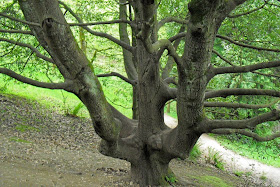 |
| My favorite photo |
 |
| Stone House. See bottom for further information on this landmark |

Forest is located in Portland, OR.
I have ran many miles here.
All photos were taken by me.
Go to the Forest Park Conservancy for trail information.
An abundance of wildlife (more than 112 bird and 62 mammal species) can be found in Forest Park. With its massive tree canopy and substantial undergrowth, the park serves as a natural air purifier, water collector, and erosion controller.
The 30-mile Wildwood Trail in Forest Park is part of the region’s 40-Mile Loop system that links Forest Park to pedestrian and trail routes along the Columbia River to Gresham, through southeast Portland, along the Willamette Greenway, and back to the Marquam Trail in southwest Portland. A landmark on the trail is the Stone House. This structure was built in the mid-1930s by the Works Progress Administration (WPA) as a public restroom. The infamous Columbus Day storm on October 12, 1962, took out the water line. Because the structure had been heavily vandalized over the years, the decision was made to gut the building rather than embark on costly repairs. It remains as a favorite spot to rest along the trail.
An abundance of wildlife (more than 112 bird and 62 mammal species) can be found in Forest Park. With its massive tree canopy and substantial undergrowth, the park serves as a natural air purifier, water collector, and erosion controller.
The 30-mile Wildwood Trail in Forest Park is part of the region’s 40-Mile Loop system that links Forest Park to pedestrian and trail routes along the Columbia River to Gresham, through southeast Portland, along the Willamette Greenway, and back to the Marquam Trail in southwest Portland. A landmark on the trail is the Stone House. This structure was built in the mid-1930s by the Works Progress Administration (WPA) as a public restroom. The infamous Columbus Day storm on October 12, 1962, took out the water line. Because the structure had been heavily vandalized over the years, the decision was made to gut the building rather than embark on costly repairs. It remains as a favorite spot to rest along the trail.
Historical Information
In 1803, William Clark (of Lewis and Clark fame) paddled far enough up the Willamette River to see Forest Park's present location. He described this forest as having Douglas fir as its predominant tree, with trunks ranging from five to eight feet in diameter.
From almost the earliest time of subsequent European settlement along the confluence of the Columbia and Willamette Rivers, the vision of a great natural park along the eastern slope of Portland's northwest hills, which Native Americans called the Tualatin Mountains, was pursued over the years by various civic leaders. The first of these visionaries was the Reverend Thomas Lamb Eliot who arrived in Portland in 1867. His persistence led to the formation of the Municipal Park Commission of Portland in 1899. The Commission brought in the famous landscape architecture firm, Olmsted Brothers of Brookline, Massachusetts, to prepare a park planning study for the City in 1903. Their recommendations included the development of the 40-mile Loop and the acquisition of the wooded hills west of the Willamette River for a park with a wild, woodland character. In their report, they maintained that "...a visit to the woods would afford more pleasure and satisfaction than a visit to any other sort of park..." and "...no use to which this tract of land could be put would begin to be as sensible or as profitable to the city as that of making it a public park."
Frederick Van Voorhies Holman, a prominent lawyer in Portland during the 1890s and a president of the Oregon Historical Society, donated a 52-acre parcel to what would become Forest Park. Part of the Holman property had been flushed down to Guild's Lake by Lafe Pence's flume in 1909. After Pence was brought to task, Holman had a plaster of paris scale model made of the property to estimate how much it would cost to return the property to its original contours in order to develop it. Discouraged by the City from taking such a great risk, he offered the property as a park if the property between it and Macleay Park were acquired. The property was donated to the city by his siblings George F. and Mary Holman on August 16, 1939.
Various setbacks delayed the formation of the forested park, including rumors of oil existing in the hillside, until the City Club of Portland undertook a feasibility study which it published in 1945. From there the 'Committee of Fifty' civic leaders persevered until 4,200 acres were formally dedicated as Forest Park on September 23, 1948. Additional acres have been added over the years; Forest Park now includes over 5,100 wooded acres making it the largest, forested natural area within city limits in the United States.
http://www.portlandonline.com/parks/finder/index.cfm?PropertyID=127&action=ViewPark





































No comments:
Post a Comment